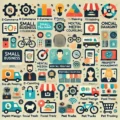The Next Generation of Education: Learning in the Age of Technology
The Next Generation of Education: Learning in the Age of Technology
As we stand at the cusp of a new era in education, it’s hard not to feel a sense of excitement and trepidation. The traditional model of learning – one that’s been around for centuries – is rapidly evolving, driven by technological advancements that are revolutionizing the way we acquire knowledge and skills. Gone are the days of dusty textbooks, chalkboards, and tedious lectures. Welcome to the age of technology-enhanced education, where learning is no longer just about sitting in a classroom, but about exploring, creating, and collaborating in a world that’s increasingly digital.
The Shift from Traditional to Tech-Driven Education
In the not-so-distant past, education was largely a linear process. Students would attend school, absorb information from their teachers, complete assignments, and eventually graduate. While this model had its merits, it had several limitations. For one, it didn’t account for individual learning styles or pace; students who learned faster were forced to wait while their peers caught up, while those who struggled behind often fell further behind. Additionally, traditional education often failed to provide hands-on experience or real-world applications, leaving many graduates unprepared for the demands of a rapidly changing job market.
Enter technology – specifically, digital tools and platforms that have transformed the way we learn and interact with information. The internet has made it possible to access vast amounts of knowledge from anywhere in the world, at any time. Online courses, MOOCs (Massive Open Online Courses), and social learning networks have democratized education, making it more accessible and inclusive than ever before.
The Rise of Personalized Learning
One of the most significant benefits of technology-enhanced education is personalized learning. Gone are the days of one-size-fits-all instruction; today’s students can choose from a wide range of courses, resources, and activities tailored to their individual needs and interests. With AI-powered adaptive platforms, teachers can now create customized learning paths for each student, adjusting the difficulty level and pace of lessons in real-time.
This approach has numerous advantages. Students who learn at an accelerated pace can be challenged with more complex material, while those who struggle can receive additional support without feeling embarrassed or left behind. Personalized learning also allows educators to identify areas where students need extra help, enabling them to provide targeted interventions and improve overall outcomes.
The Power of Online Learning Communities
Another significant aspect of modern education is the rise of online learning communities. Social media platforms, online forums, and virtual classrooms have created new spaces for students to connect with peers, share ideas, and collaborate on projects. These networks foster a sense of belonging, encourage active participation, and provide opportunities for feedback and support.
Online learning communities also enable students to engage with experts from around the world, gaining insights into various disciplines and industries. This can be particularly valuable for students who may not have access to specialized resources or mentors in their local area. By connecting with others through online platforms, learners can expand their professional networks, build relationships with like-minded individuals, and stay up-to-date with industry trends.
The Role of AI in Education
Artificial intelligence (AI) has revolutionized the education sector in numerous ways. From grading assignments to creating personalized learning plans, AI-powered tools are automating routine tasks, freeing educators to focus on what matters most – teaching and mentoring.
One notable example is AI-driven intelligent tutoring systems (ITSs), which offer one-on-one support to students in real-time. These platforms use machine learning algorithms to analyze a student’s strengths, weaknesses, and knowledge gaps, providing targeted feedback and guidance as needed.
AI also enables educators to create more engaging and interactive content, such as virtual reality experiences, gamified lessons, and adaptive assessments. By leveraging AI-powered tools, teachers can make their classrooms more dynamic, immersive, and effective.
The Future of Higher Education
As we look ahead to the future, higher education is poised for a significant transformation. With online learning platforms like Coursera, edX, and Udacity, students can now access top-tier courses from leading universities worldwide. This democratization of higher education has opened doors for millions of learners who may have been previously unable to afford or access these opportunities.
In addition to online courses, there’s a growing trend towards competency-based progression – where students advance through their programs based on demonstrated mastery rather than seat time or age. This approach allows learners to move at their own pace, taking on challenges and responsibilities as they progress.
The Impact of Technology on Teacher Training
While technology has revolutionized the way we learn, it also poses significant challenges for educators. Teachers must now adapt to new tools, platforms, and pedagogies, which can be daunting, especially for those who are less tech-savvy.
To address this issue, many institutions are investing in teacher training programs that focus on digital literacy, instructional design, and technology integration. By providing educators with the skills they need to effectively utilize technology, we can ensure a smoother transition to the next generation of education.
The Ethics of Technology-Enhanced Education
As we integrate more technology into our educational systems, it’s essential to consider the ethics surrounding this shift. Some concerns include:
- Data collection and privacy: With so much data being generated through online platforms and AI-powered tools, there are legitimate worries about student data security and surveillance.
- Equity and access: Will students from disadvantaged backgrounds be able to access these new technologies and opportunities?
- Bias in AI systems: Can we trust AI-driven decision-making systems to provide fair and unbiased outcomes?
To mitigate these risks, educators, policymakers, and industry leaders must work together to establish clear guidelines and regulations around the use of technology in education. This includes ensuring that online platforms are accessible, user-friendly, and inclusive for all learners.
Conclusion
The next generation of education is upon us – an era marked by technological innovation, personalized learning, and global connectivity. While there are many challenges to overcome, the benefits of this shift are undeniable. By harnessing the power of technology, we can create more effective, efficient, and engaging educational experiences that prepare students for a rapidly changing world.
As we continue to evolve and adapt to these changes, it’s essential to prioritize equity, accessibility, and student-centered learning. By doing so, we can unlock the full potential of technology-enhanced education and build a brighter future for learners everywhere.







